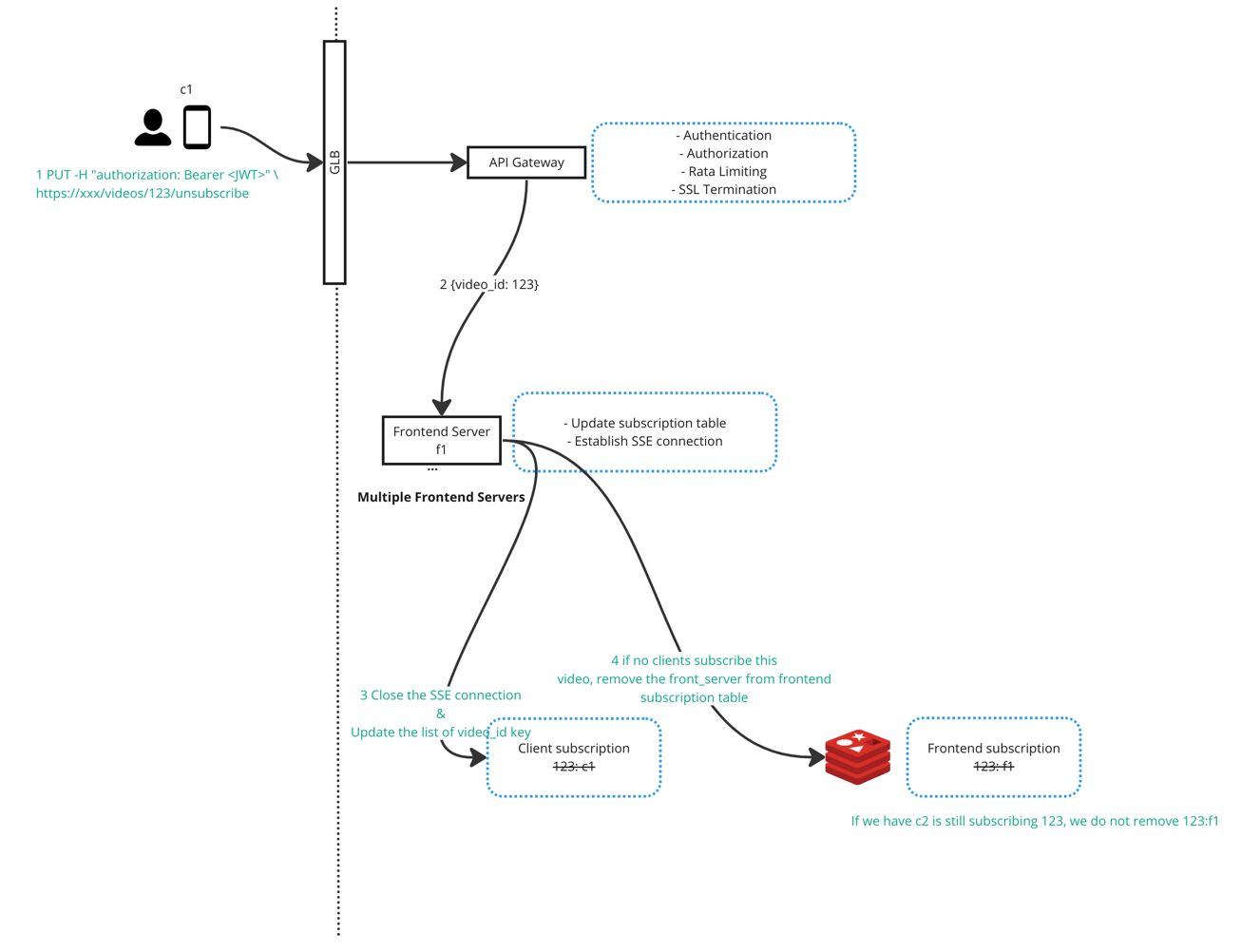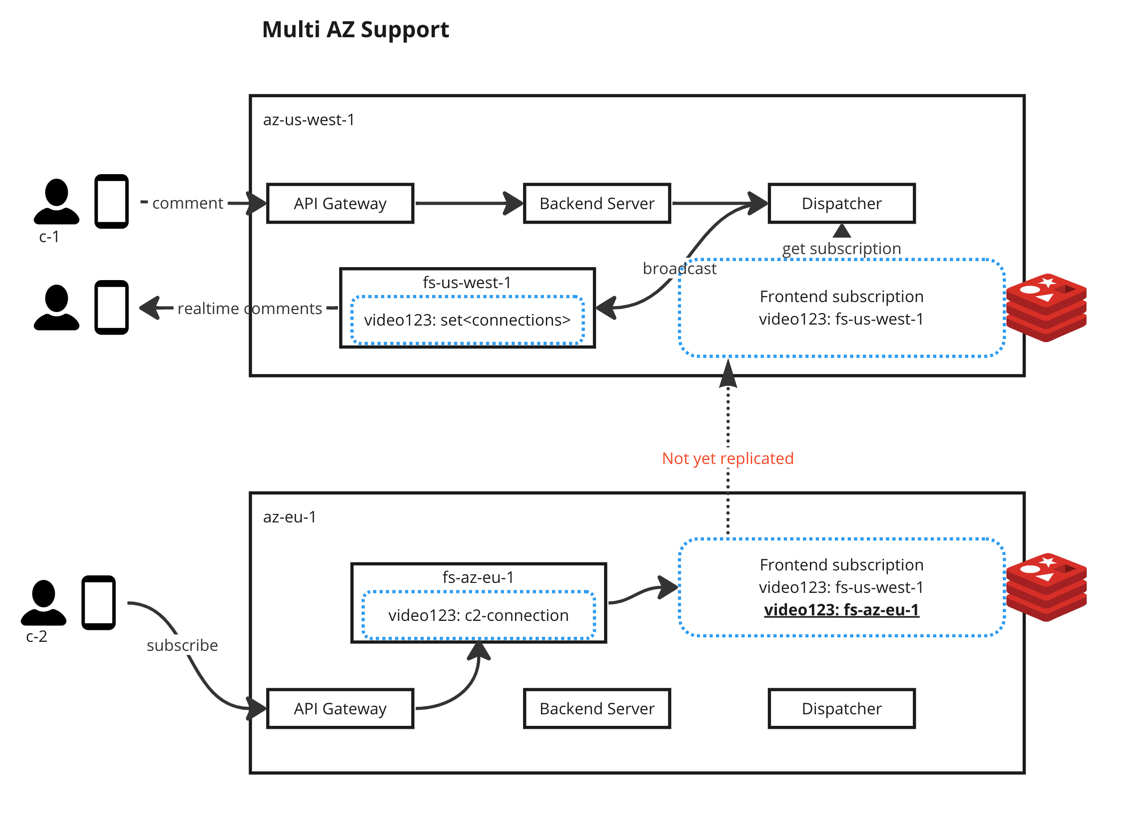Realtime comments on live video
Requirements and User stories
Functional requirements
- As a viewer, I want to post comments on a live video to interact with streamer.
- As a viewer/streamer, I want to see realtime comments from other viewers.
- As a viewer, I shuold be able to see a history of comments when I join a live video and scroll up on.
- The realtime comment service should handle clients across the globe.
- The realtime comment service should handle millions of concurrent clients.
- ?? Will live video be stored when it’s ended ?
Non functional requirements
- Low latency: We should be able to see the realtime comments as soon as it’s available with low latency
- HA/Fault tolerance
- Scalability
- Eventual consistency
Calculation
- Daily active users: 100 million
- Total daily live videos: 200 million
- Peak concurrent users watching the same live videos: 80 million
- Read:Write ratio of realtime comments: 100:1 (Read Heavy)
Data model
type User struct {
UserID int64
Name string
Email string
...
}
type Video struct {
VideoID int32
UserID int64 // the streamer
Title string
}
type Comment struct {
UserID int64 // the viewer who publish a comment.
VideoID int32 // signed int32 can handle 2 billion unique IDs.
CommentID int32
Text string // content of the comment.
Timestamp Time
}
- If we don’t store the live video when it ends, then int32 should be good enough because our assumption is to have 200
million daily live videos. Signed
int32can handle 2 billion unique IDs.
APIs
Subscribe to a video
An authenticated and authorized user needs to subscribe to a video in order to view/publish the realtime comments.
Accept:text/event-stream header is telling server that we want to use
SSE over HTTP. After a user
subscribes a video, the backend service will maintain a map so server knows where to broadcast the realtime comments.


curl -X PUT -H "Accept:text/event-stream" -H "authorization: Bearer <JWT>" \
https://xxx/videos/<video_id>/subscribe
status code: 200 OK
content-type: text/event-stream
# The content-type: text/event-stream HTTP response header indicates that the server established an open connection to
# the event stream to dispatch events to the client. The response event stream contains the live comments.
---
id: 1
event: comment
data: {"comment": "awesome", "user": "sleepybear"}
data: {"comment": "hey there", "user": "winterwolfe"}
Unsubscribe from a video
curl -X DELETE -H "authorization: Bearer <JWT>" https://xxx/videos/<video_id>/unsubscribe/<connection_id>
status code: 200 OK
When a user unsubscribes a video, the backend service will remove the server side map record, so no more realtime comments will be sent to that client.
Publish a comment
curl -X PUT -H "authorization: Bearer <JWT>" -d {"user_id": "xxx", "comment": "Hello from San Jose!"} \
https://xxx/videos/<video_id>/comments
status code: 200 OK
Comparisons of pull-based(client-initiated) vs push-based(server-initiated)
- Push-based: Server proactively initiates the communication.
- Pull-based: Client initiates the communication. (Once connection is established, server can broadcasts events data)
We choose Pull-based model, because of the following reasons:
- Viewer’s connection is unpredictable.
- Server only sends realtime comments to subscribers who are online/connected. Subscription and online/offline is client side behavior which cannot be managed by server.
- Viewer is geographically distributed across the globe.
Long Poling vs SSE vs Websocket
See here for more details.
Comparison of each protocols

- Not picking Webhook is because: 1) Server push based 2) It’s not designed for frequent communication, each time when server wants to broadcast the events, a new connection will be established again.
- Not picking WebSub is because: 1) Server push based 2) It’s not designed for frequent communication (this is based on webhook)
- Why cannot we use WebSocket ? 1) Websocket is bi-directional, mostly used in gaming/collaborative application. We are read heavy in realtime comment service. 2) Websocket is a separate protocol from HTTP, SSE is built on top of HTTP.
Architecture
Data Store
Why do we need a data store
Take YouTube Live stream as the example, when streamer ends the live streaming the video will be persisted along with all the comments/chat history. So if that is the case, we need the data store to at least persist streamed video and the comments. The scope of this design is to focus on storing comments.
Requirements on data store
- Optimized read performance (Read heavy)
- A good support for horizontal scaling.
- Highly distributed to support global users.
- Fault tolerant. When a node is down or has network partition, there is no customer impact.
Capacity planning
- 200 million live video/day * 10 comments/video = 2 billion (comments/day)
UserID int64 // 8 bytes
VideoID int32 // 4 bytes
CommentID int32 // 4 bytes
Text string // 20480 bytes
Timestamp Time // 8 bytes
- 2 (KB/comment) * 2 billion (comment/day) = 4 billion KB / day = 4 TB / day
Relational database
Let’s use MySQL and PostgreSQL as an example.
- Fixed data schema which makes it hard to extend. Today we support text only comments, what if we want to extend to support emoj or pictures. Making changes to schema is expensive.
- Leader/Master based replication model. All writes need to be redirect to leader/master/primary node which slows down the performance. Given that we are read heavy, this replication model might be ok for now.
- Focus more on consistency, so it has to sacrifice on either Availability or Partition Tolerance. In our case, we do not have strong consistency requirement.
More readings:
- https://cloud.google.com/architecture/architectures-high-availability-postgresql-clusters-compute-engine
- https://en.wikipedia.org/wiki/MySQL_Cluster
Conclusion: Relational database might not be an optimal choice
NoSQL database
Let’s take Cassandra as an example.
- Wide column. If we want to extend comment data model to support more than just text, it can be easily done by adding a new column.
- LSM tree based storage engine offers extremely high performance on writes. LSM tree based storage engine could be slow on read (we need to scan memtable first and then potentially multiple SSTables on disk). Bloom filter is used to improve the read performance.
Conclusion: NoSQL database is more flexible in terms of scalability. Consider using NoSQL to store comments.
Comments can be stored as individual rows within a table. Each of the following properties are mapped to each column:
type Comment struct {
UserID int64 // the viewer who publish a comment.
VideoID int32 // signed int32 can handle 2 billion unique IDs.
CommentID int32
Text string // content of the comment.
Timestamp Time
}
CREATE TABLE comments (
video_id uuid,
comment_time timestamp, // Clustering key for creation time ordering
comment_id uuid, // Unique identifier for comments
user_id uuid,
comment_text text,
PRIMARY KEY (video_id, comment_time) // video_id is the partition key; comment_time is the cluster key column
);
See this blog to learn more on Cassandra clustering keys.
When we do query from Cassandra, we can do:
select * from comments
where video_id = 'app1'
and comment_time > '2021-08-13T00:00:00';
Handle old comments
Based on our estimate, we have 4 TB / day used for storing comments. That is roughly 1.2 PB storage / year. We definitely need to consider compress or remove old comments.
TODO: How to compress ? How does Netflix compress the view history ?
Cache layer
High Level Design & Workflows
Subscribe & Unsubscribe


import org.springframework.http.MediaType;
import org.springframework.web.bind.annotation.GetMapping;
import org.springframework.web.bind.annotation.RequestMapping;
import org.springframework.web.bind.annotation.RestController;
import reactor.core.publisher.Flux;
import java.time.Duration;
import java.time.LocalTime;
import java.util.Map;
import java.util.concurrent.ConcurrentHashMap;
public class Connection {
String userID;
Flux<String> flux;
public Connection(String userID, Flux<String> flux) {
this.userID = userID;
this.flux = flux;
}
}
@RestController
public class SSEController {
private final Map<String, List<Flux<String>>> videoSubscriptions = new ConcurrentHashMap<>();
private final Map<String, Flux<String>> activeConnections = new ConcurrentHashMap<>();
@GetMapping("/subscribe", produces = MediaType.TEXT_EVENT_STREAM_VALUE)
public Flux<String> subscribe() {
// Generate a unique identifier for the client
String videoId = <some-code-to-get-video-id-from-request>;
String userId = <get-userId=from=request>;
// Create a Flux to send SSE events to the client
Flux<String> flux = Flux.interval(Duration.ofSeconds(1))
.map(sequence -> "data: Server time is " + LocalTime.now() + "\n\n")
.doOnCancel(() -> {
// Cleanup resources when the client disconnects
System.out.println("Client disconnected: " + userId);
// Remove the disconnected client from the registry
activeConnections.get(userId).close();
});
// Add the new connection to the registry
videoSubscriptions.get(videoId).add(flux);
activeConnections.put(userId, flux);
return flux;
}
// Example method to broadcast a message to all active connections
public void broadcastMessage(String message) {
// Iterate through the active connections and send the message
videoSubscriptions.forEach((videoId, connections) -> {
for (Flux<String> f : connections) {
// Add the broadcast logic here
// clean up the close connection
}
});
}
}
Realtime comments distribution

import org.springframework.beans.factory.annotation.Autowired;
import org.springframework.web.bind.annotation.PostMapping;
import org.springframework.web.bind.annotation.RequestBody;
import org.springframework.web.bind.annotation.RequestMapping;
import org.springframework.web.bind.annotation.RestController;
@RestController
@RequestMapping("/comments")
public class CommentsController {
private final SSEController sseController;
@Autowired
public EventController(SSEController sseController) {
this.sseController = sseController;
}
@PostMapping
public void handleEvent(@RequestBody String eventData) {
// Process the received event, perform any necessary logic
// Broadcast a message to all connected clients
sseController.broadcastMessage("New Event: " + eventData);
}
}
Failure handling
Frontend server failure

SSE connection is initiated by client, no matter what causes the disconnection server cannot reestablish the connection.
When a frontend server node is down, we lose all the connections between clients to that frontend server. Dispatcher will continue sending messages/events/comments to that frontend server node (but cannot reach).
- Client’s heartbeat signal cannot reach the frontend server node, an indicator/notification can be sent to client. Client can “refresh” to reestablish the SSE connection.
- API Gateway detects the front server node down, it will not redirect any request to that node.
- Dispatcher detects the front server node down (because it cannot reach it), dispatcher will update its own subscription record.
Dispatcher failure
Dispatcher can be stateless, we pulled out the <video_id>:set<frontend_node>out to Redis. That Redis is shared among
all dispatchers. Backend server can retry another dispatcher. The only drawback is latency.
TODO What will happen if API Gateway fails
TODO What will happen if GLB fails
Scaling
Multi AZ support

Challenges
- c-2 subscribes to
video-123from AZaz-eu-1. Subscription table has been updated in local AZ. - c-1 sends comments on
video-123from AZaz-us-west-1. The subscription table underas-us-west-1does not know c-2’s subscription (but eventually it will know). - c-2 will not get realtime comments from another AZ. (Latency)
Solution - 1
- Allows the across-az latency
- Dispatcher will eventually broadcast comments to all subscribed frontend servers
Solution - 2
Whenever a local dispatcher receives an event, it also sends the event to other dispatchers in other AZs.
(This is what Linkedin uses) The downside is that az-apec-1 has no subscriptions on video-123, it will always
receive the events, this increases the load of dispatcher.
